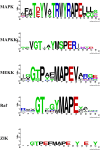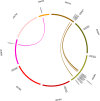Genome-wide identification, expression profiles and regulatory network of MAPK cascade gene family in barley
- PMID: 31623562
- PMCID: PMC6796406
- DOI: 10.1186/s12864-019-6144-9
Genome-wide identification, expression profiles and regulatory network of MAPK cascade gene family in barley
Abstract
Background: Mitogen-activated protein kinase (MAPK) cascade is a conserved and universal signal transduction module in organisms. Although it has been well characterized in many plants, no systematic analysis has been conducted in barley.
Results: Here, we identified 20 MAPKs, 6 MAPKKs and 156 MAPKKKs in barley through a genome-wide search against the updated reference genome. Then, phylogenetic relationship, gene structure and conserved protein motifs organization of them were systematically analyzed and results supported the predictions. Gene duplication analysis revealed that segmental and tandem duplication events contributed to the expansion of barley MAPK cascade genes and the duplicated gene pairs were found to undergone strong purifying selection. Expression profiles of them were further investigated in different organs and under diverse abiotic stresses using the available 173 RNA-seq datasets, and then the tissue-specific and stress-responsive candidates were found. Finally, co-expression regulatory network of MAPK cascade genes was constructed by WGCNA tool, resulting in a complicated network composed of a total of 72 branches containing 46 HvMAPK cascade genes and 46 miRNAs.
Conclusion: This study provides the targets for further functional study and also contribute to better understand the MAPK cascade regulatory network in barley and beyond.
Keywords: Barley; Gene family; MAPK cascade; Regulatory network.
Conflict of interest statement
The authors declare that they have no competing interests.
Figures








References
MeSH terms
Substances
Grants and funding
LinkOut - more resources
Full Text Sources

